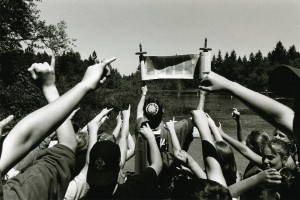Jewish Lens Mini Course - Lesson 2: Image and Text
| Overview: | Photographs and written texts can complement one another in communicating concepts and ideas.
In this lesson, students explore the relationship between image and text, and how each can illuminate the other. First, the class discusses two additional aspects of composition to aid them in their Photo Mission later in the lesson. In pairs, they then observe two photographs and select a text from Worksheet B that resonates with one of the images. They then take their own photographs that reflect the meaning of a chosen text. |
| Schedule: | 1-2 Class Sessions
|
| Materials: |
|
| Preparation: | Set up projector to display the photographs. If laptop and projector are not available, make high-resolution photocopies of the photograph to distribute to students. Also, make enough copies of Worksheet B for the class, and be sure that there are enough cameras for each pair of students. |
| Goals: |
|
| Big Idea: | Photographs and written texts can complement each other in communicating concepts and ideas. |
Summer Camp, Tumwater, Washington, 2002
Introductory Composition Lesson (10-20 minutes)
This section builds on the “Composing a Photograph” section from Lesson Plan 1: Reading a Photograph. Here the students will be encouraged to think more carefully about composing an image through an introduction to the ‘Rule of Thirds’ technique and a brief analysis of, and discussion about, the use of lighting in photography.
The Rule of Thirds
The rule of thirds is one of the fundamentals of photography; a technique designed to help photographers create a more interesting photograph.
Show the students Zion Ozeri’s photograph “Summer Camp.” Show the class how with this technique, we divide a composition into nine squares of equal size (as we see in the image below), with two horizontal lines intersecting two vertical lines. If we then align our subjects with the guidelines and their intersection points, the subjects aren’t centered; rather, the focal point is slightly off to one side. Explain that this technique draws the viewer’s eye into the composition, instead of just glancing at the center.
This is a method adopted by many photographers and can be used to enhance students’ photography skills; however, remember to mention that it is a compositional tool to be experimented with and is in no way a rule that must be strictly adhered to.
Tell the students that during their Photo Mission later in the lesson, they can play around with this technique by imagining the grid as they look through the viewfinder and compose their image.



Light and Dark
Lighting can make or break an image. To get your students to think carefully about light when they are using their cameras, use the following three images to discuss ways in which photographers use light and dark to create particular effects.

Between Light and Darkness – Michael Sanders, USA – 2018
“The smallest glimmer of light stands out in the darkness, and no matter how dark things may seem, there is always light. This expresses the strength of the Jewish people. Others have tried to wipe out our people many times, but no one has succeeded. We are a minority. Although small, we always illuminate the darkness.”
Michael has used candlelight in an unlit room to create a stark contrast here between light and dark. Our eyes are instantly drawn to the center of the image – to the candlelight, and the person holding it. The effect is dramatic and conjures up images of candle-lighting rituals, as well as a beacon of light – a light unto the nations.
 Ray of Light – Aaron Yadegar, USA – 2018
Ray of Light – Aaron Yadegar, USA – 2018
“Betty is a Holocaust survivor. The greatest lesson that I learned from Betty is that no matter what, if you have courage and strength in yourself, everything will turn out just fine.”
Aaron has also used the contrast between light and dark in his photograph – this time to highlight a person in a portrait. Here his subject, Betty, is lit up and the background is completely dark so that there are no distractions. Generally, lighting should come from behind the camera in this way, students should avoid backlighting unless it is intended.
Aaron has used artificial lighting, creating the effect of many different colors on Betty’s face and clothes – this colorfulness is perhaps intended to express something about her character.
 Freedom, Max Yaffe – Mexico, 2018
Freedom, Max Yaffe – Mexico, 2018
“This picture was taken in Kibbutz Hatzerim in the south of Israel and represents the freedom of life experienced in Israel and the fulfillment of the Zionist dream. Music and movement are expressions of Jewish creation and creativity, helping us face a new day that looks towards the future.”
Here, Max has intentionally used backlighting – utilizing natural light – to create a silhouette effect. Experimenting with natural light and learning how to harness it is a great way for students to improve their images.
Generally, natural light is at its best either at the beginning or at the end of the day. At midday, the light from the sun can be quite harsh, whereas shortly after the sun has risen in the morning and just before it sets at night (referred to by photographers as the ‘golden hour’), the light can change from being hard and dramatic (as you see in Max’s photo above) to softer tones that enhance colors.
Encourage your students to experiment with natural light by taking notice of the quality and quantity of light depending on the location, weather conditions, and time of day.
Next time they are out taking photographs they can ask themselves: Does the light suit the subject? Would the light be better at a different time of day, or under different weather conditions?
Meme Activity (10-15 Minutes)
Ask the class: What is a meme?
Display some memes to the class, such as the following:

A meme is an idea, a behavior, or a style that spreads from person to person within a culture.
An internet meme spreads from person to person via social media. It can be made up of just an image, a word, or a phrase. In the memes above, we see the two combined. Here text and image work together to communicate a message more effectively than either could alone. Today we are going to analyze further the relationship between image and text.
In the memes above, a funny message is relayed by combining text and image. We’re now going to attempt to pair text and image to portray important ideas and meaningful expressions of Jewish life.
Show the students the following image and, in pairs or small groups, ask them to come up with a caption for it. Such as:

La Chuppah – Shayna Kling, Mercaz Jewish High School Cincinnati, Ohio, USA

Three Threads – Micaela Norambuena, Instituto Hebreo Santiago, Chile
Image and Text (15 minutes)
 Summer Camp – Zion Ozeri, Tumwater, Washington, 2002
Summer Camp – Zion Ozeri, Tumwater, Washington, 2002
 Values – Sofia Mijal Listovsky, Noar Panama, Panama City, Panama, 2018
Values – Sofia Mijal Listovsky, Noar Panama, Panama City, Panama, 2018
Show the class the two photos: “Summer Camp” by Zion Ozeri and “Values” by Sofia Mijal Listovsky.
Divide the class into pairs and give each a copy of Worksheet B.
Have each pair of students read the texts on Worksheet B and choose one text that they believe connects best with one of the photographs.
Ask a few pairs to share the texts they chose with an explanation.
Text and Image – Photo Mission (20-30 minutes)
Have each pair go out into the building or outdoors to take photographs of each other or of their surroundings to illustrate one of the texts on Worksheet B that “speaks” to them. The photographs can be literal or metaphorical, posed or candid, narrative or poetic.
Remind students to plan their shots carefully. Before shooting, they should think about what they want to express and how they will do so. Encourage students to consider the compositional aspects from Lessons One (Framing) and Two (Rule of Thirds and Lighting).
Although the students should experiment by taking many photographs, they will choose one photograph to show the rest of the class. Students can make simple edits to their selected photograph (cropping, rotation) on their phones if they desire.
Share Photographs (5-20 minutes)
Ask each pair to share one photograph.
Discuss:
How do you think your photo captured the selected quote? Explain your pair’s process.
Was this different from past picture-taking experiences? How?
Did your shots come out the way you intended? Why or why not?
Optional Take-Home Project
For additional reflection, use the questions above as the basis of a journal-writing activity.
Another option: Create Jewish memes to upload to Instagram. Tag #JewishLens and share with the class next week.
Additionally, have students practice their new compositional knowledge by taking additional photos that show their connection to Judaism as practice for their Final Assignment. Students can then upload a photo to Instagram and tag the Jewish Lens Instagram page.


